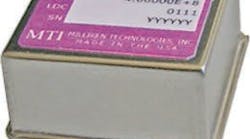To serve applications requiring insensitivity to accelerationbeyond the levels that are possible through conventional solutionsthe 222 series of rugged, oven-controlled crystal oscillators (OCXOs) has made its debut. Operating either as a standalone product or in tandem with mechanical shock and vibration-reducing systems, this series vows to reduce the effects of acceleration on phase noise to levels near or below the noise floor. The 222 series is designed to operate in high acceleration and vibration environments ranging to 20 g RMS from 20 Hz to 2 kHz. The oscillators in this series boast low g-sensitivity below 1 x 10-10/g/ axis. They deliver thermal stability to 2 x 10-8 over 100C. The oscillators can cover a temperature range of -55 to +95C. They include an internal, 24-b digital-to-analog converter (DAC) for nonvolatile calibration via I2C bus. Optionally, a traditional analog tuning voltage input is available as well. Among the available options are internal ROM data storage, shock and vibration systems, and screening per MIL-PRF-55310. The oscillators, which are factory optimized for the customer's vibration profile, come in a hermetic packaging measuring 1.0 x 1.0 x 0.565 in. With the oscillators' g-sensitivity and overall stability, they are well suited for clean-up loops following GPS clocks, Cesium or Rubidium frequency standards, and optical-communications links. They also target military applications like unmanned aerial vehicles (UAVs), rotorcraft, and tracked vehicles, as well as harsh industrial environments.
MTI - Milliren Technologies, Inc.
Two New Pasture Rd.
Newburyport, MA 01950
(978) 465-6064, FAX: (978) 465- 6637
www.mti-milliren.com

